INFS 5091 - Case Study on IT Procurement and Vendor Management
VerifiedAdded on 2023/06/11
|8
|2794
|438
Report
AI Summary
This report presents a comprehensive case study analysis of IT procurement and vendor management, addressing ten key questions related to the field. It begins by outlining the four processes of project procurement management as defined by PMBok 5th Edition, followed by an explanation of the four essential components of an enforceable contract and the three necessary elements of an offer. The report then discusses the differences between independent and dependent demand, explores the hidden costs associated with outsourcing, and explains the relationship between Total Quality Management (TQM) and IT procurement. Furthermore, it delves into the psychological factors influencing bargaining, contrasts IT procurement practices with pure economic practices, examines key procurement considerations for cloud SaaS offerings, and explains how the critical path should be integrated into a Statement of Work (SOW). The analysis is supported by academic literature, providing a well-rounded perspective on the complexities and considerations within IT procurement and vendor management.
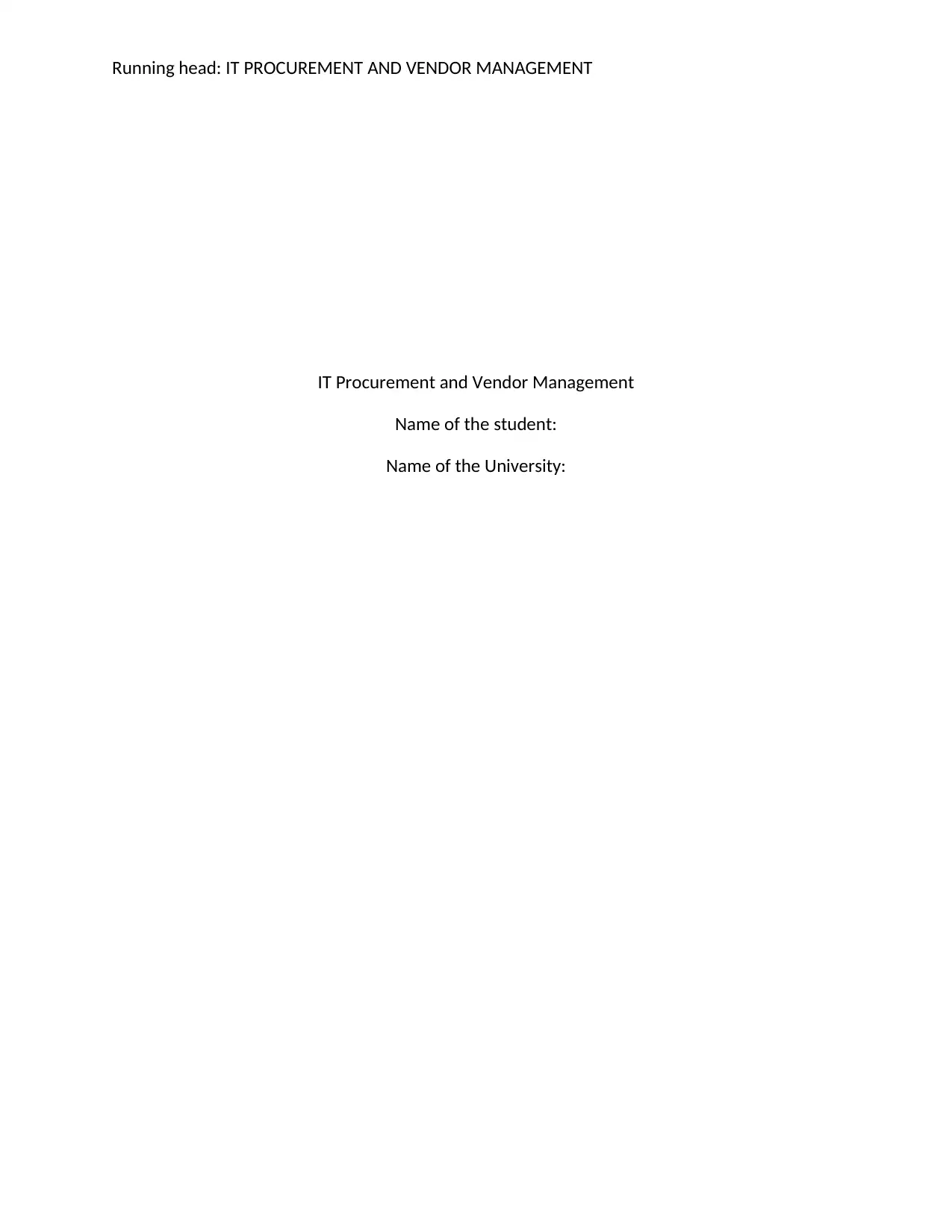
Running head: IT PROCUREMENT AND VENDOR MANAGEMENT
IT Procurement and Vendor Management
Name of the student:
Name of the University:
IT Procurement and Vendor Management
Name of the student:
Name of the University:
Paraphrase This Document
Need a fresh take? Get an instant paraphrase of this document with our AI Paraphraser
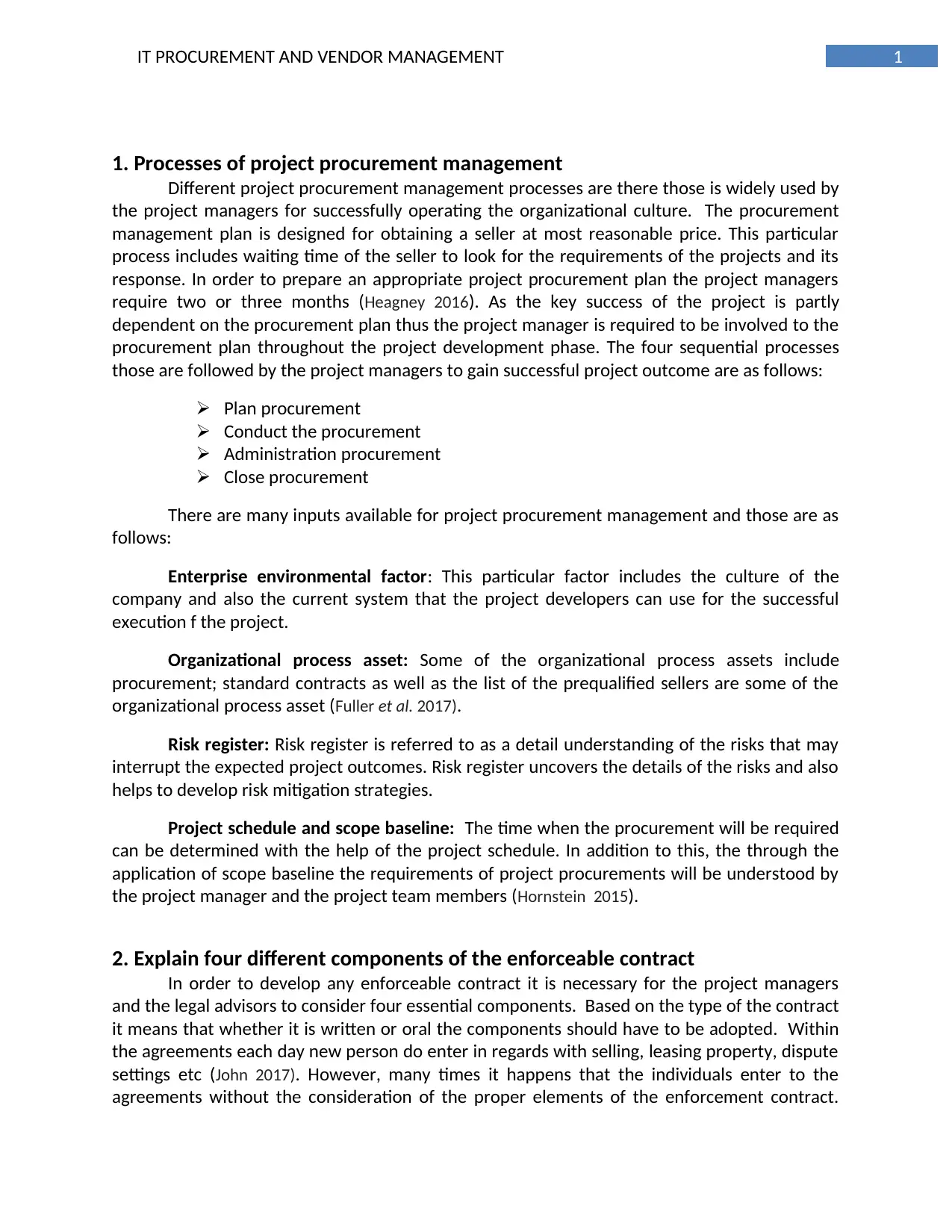
1IT PROCUREMENT AND VENDOR MANAGEMENT
1. Processes of project procurement management
Different project procurement management processes are there those is widely used by
the project managers for successfully operating the organizational culture. The procurement
management plan is designed for obtaining a seller at most reasonable price. This particular
process includes waiting time of the seller to look for the requirements of the projects and its
response. In order to prepare an appropriate project procurement plan the project managers
require two or three months (Heagney 2016). As the key success of the project is partly
dependent on the procurement plan thus the project manager is required to be involved to the
procurement plan throughout the project development phase. The four sequential processes
those are followed by the project managers to gain successful project outcome are as follows:
Plan procurement
Conduct the procurement
Administration procurement
Close procurement
There are many inputs available for project procurement management and those are as
follows:
Enterprise environmental factor: This particular factor includes the culture of the
company and also the current system that the project developers can use for the successful
execution f the project.
Organizational process asset: Some of the organizational process assets include
procurement; standard contracts as well as the list of the prequalified sellers are some of the
organizational process asset (Fuller et al. 2017).
Risk register: Risk register is referred to as a detail understanding of the risks that may
interrupt the expected project outcomes. Risk register uncovers the details of the risks and also
helps to develop risk mitigation strategies.
Project schedule and scope baseline: The time when the procurement will be required
can be determined with the help of the project schedule. In addition to this, the through the
application of scope baseline the requirements of project procurements will be understood by
the project manager and the project team members (Hornstein 2015).
2. Explain four different components of the enforceable contract
In order to develop any enforceable contract it is necessary for the project managers
and the legal advisors to consider four essential components. Based on the type of the contract
it means that whether it is written or oral the components should have to be adopted. Within
the agreements each day new person do enter in regards with selling, leasing property, dispute
settings etc (John 2017). However, many times it happens that the individuals enter to the
agreements without the consideration of the proper elements of the enforcement contract.
1. Processes of project procurement management
Different project procurement management processes are there those is widely used by
the project managers for successfully operating the organizational culture. The procurement
management plan is designed for obtaining a seller at most reasonable price. This particular
process includes waiting time of the seller to look for the requirements of the projects and its
response. In order to prepare an appropriate project procurement plan the project managers
require two or three months (Heagney 2016). As the key success of the project is partly
dependent on the procurement plan thus the project manager is required to be involved to the
procurement plan throughout the project development phase. The four sequential processes
those are followed by the project managers to gain successful project outcome are as follows:
Plan procurement
Conduct the procurement
Administration procurement
Close procurement
There are many inputs available for project procurement management and those are as
follows:
Enterprise environmental factor: This particular factor includes the culture of the
company and also the current system that the project developers can use for the successful
execution f the project.
Organizational process asset: Some of the organizational process assets include
procurement; standard contracts as well as the list of the prequalified sellers are some of the
organizational process asset (Fuller et al. 2017).
Risk register: Risk register is referred to as a detail understanding of the risks that may
interrupt the expected project outcomes. Risk register uncovers the details of the risks and also
helps to develop risk mitigation strategies.
Project schedule and scope baseline: The time when the procurement will be required
can be determined with the help of the project schedule. In addition to this, the through the
application of scope baseline the requirements of project procurements will be understood by
the project manager and the project team members (Hornstein 2015).
2. Explain four different components of the enforceable contract
In order to develop any enforceable contract it is necessary for the project managers
and the legal advisors to consider four essential components. Based on the type of the contract
it means that whether it is written or oral the components should have to be adopted. Within
the agreements each day new person do enter in regards with selling, leasing property, dispute
settings etc (John 2017). However, many times it happens that the individuals enter to the
agreements without the consideration of the proper elements of the enforcement contract.
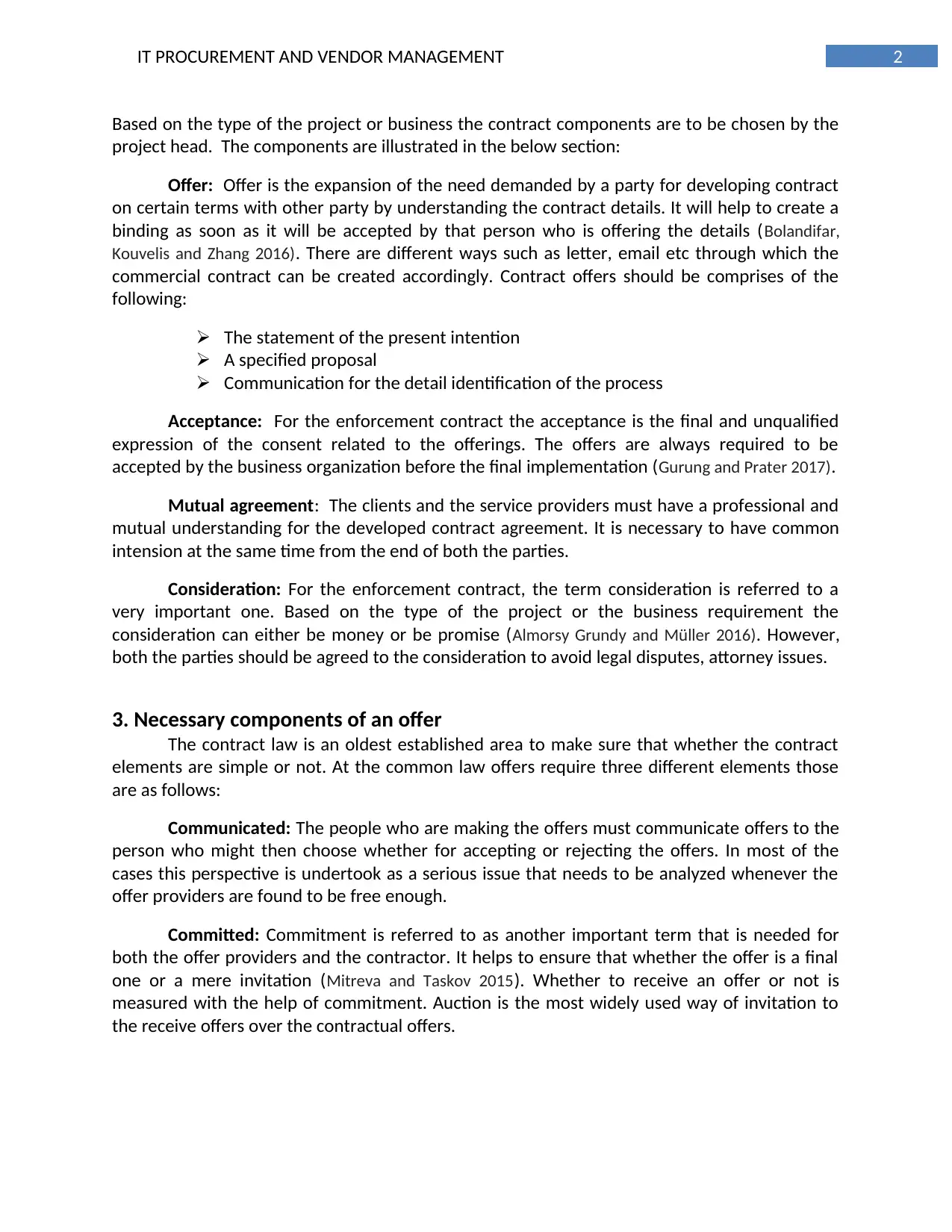
2IT PROCUREMENT AND VENDOR MANAGEMENT
Based on the type of the project or business the contract components are to be chosen by the
project head. The components are illustrated in the below section:
Offer: Offer is the expansion of the need demanded by a party for developing contract
on certain terms with other party by understanding the contract details. It will help to create a
binding as soon as it will be accepted by that person who is offering the details (Bolandifar,
Kouvelis and Zhang 2016). There are different ways such as letter, email etc through which the
commercial contract can be created accordingly. Contract offers should be comprises of the
following:
The statement of the present intention
A specified proposal
Communication for the detail identification of the process
Acceptance: For the enforcement contract the acceptance is the final and unqualified
expression of the consent related to the offerings. The offers are always required to be
accepted by the business organization before the final implementation (Gurung and Prater 2017).
Mutual agreement: The clients and the service providers must have a professional and
mutual understanding for the developed contract agreement. It is necessary to have common
intension at the same time from the end of both the parties.
Consideration: For the enforcement contract, the term consideration is referred to a
very important one. Based on the type of the project or the business requirement the
consideration can either be money or be promise (Almorsy Grundy and Müller 2016). However,
both the parties should be agreed to the consideration to avoid legal disputes, attorney issues.
3. Necessary components of an offer
The contract law is an oldest established area to make sure that whether the contract
elements are simple or not. At the common law offers require three different elements those
are as follows:
Communicated: The people who are making the offers must communicate offers to the
person who might then choose whether for accepting or rejecting the offers. In most of the
cases this perspective is undertook as a serious issue that needs to be analyzed whenever the
offer providers are found to be free enough.
Committed: Commitment is referred to as another important term that is needed for
both the offer providers and the contractor. It helps to ensure that whether the offer is a final
one or a mere invitation (Mitreva and Taskov 2015). Whether to receive an offer or not is
measured with the help of commitment. Auction is the most widely used way of invitation to
the receive offers over the contractual offers.
Based on the type of the project or business the contract components are to be chosen by the
project head. The components are illustrated in the below section:
Offer: Offer is the expansion of the need demanded by a party for developing contract
on certain terms with other party by understanding the contract details. It will help to create a
binding as soon as it will be accepted by that person who is offering the details (Bolandifar,
Kouvelis and Zhang 2016). There are different ways such as letter, email etc through which the
commercial contract can be created accordingly. Contract offers should be comprises of the
following:
The statement of the present intention
A specified proposal
Communication for the detail identification of the process
Acceptance: For the enforcement contract the acceptance is the final and unqualified
expression of the consent related to the offerings. The offers are always required to be
accepted by the business organization before the final implementation (Gurung and Prater 2017).
Mutual agreement: The clients and the service providers must have a professional and
mutual understanding for the developed contract agreement. It is necessary to have common
intension at the same time from the end of both the parties.
Consideration: For the enforcement contract, the term consideration is referred to a
very important one. Based on the type of the project or the business requirement the
consideration can either be money or be promise (Almorsy Grundy and Müller 2016). However,
both the parties should be agreed to the consideration to avoid legal disputes, attorney issues.
3. Necessary components of an offer
The contract law is an oldest established area to make sure that whether the contract
elements are simple or not. At the common law offers require three different elements those
are as follows:
Communicated: The people who are making the offers must communicate offers to the
person who might then choose whether for accepting or rejecting the offers. In most of the
cases this perspective is undertook as a serious issue that needs to be analyzed whenever the
offer providers are found to be free enough.
Committed: Commitment is referred to as another important term that is needed for
both the offer providers and the contractor. It helps to ensure that whether the offer is a final
one or a mere invitation (Mitreva and Taskov 2015). Whether to receive an offer or not is
measured with the help of commitment. Auction is the most widely used way of invitation to
the receive offers over the contractual offers.
⊘ This is a preview!⊘
Do you want full access?
Subscribe today to unlock all pages.

Trusted by 1+ million students worldwide
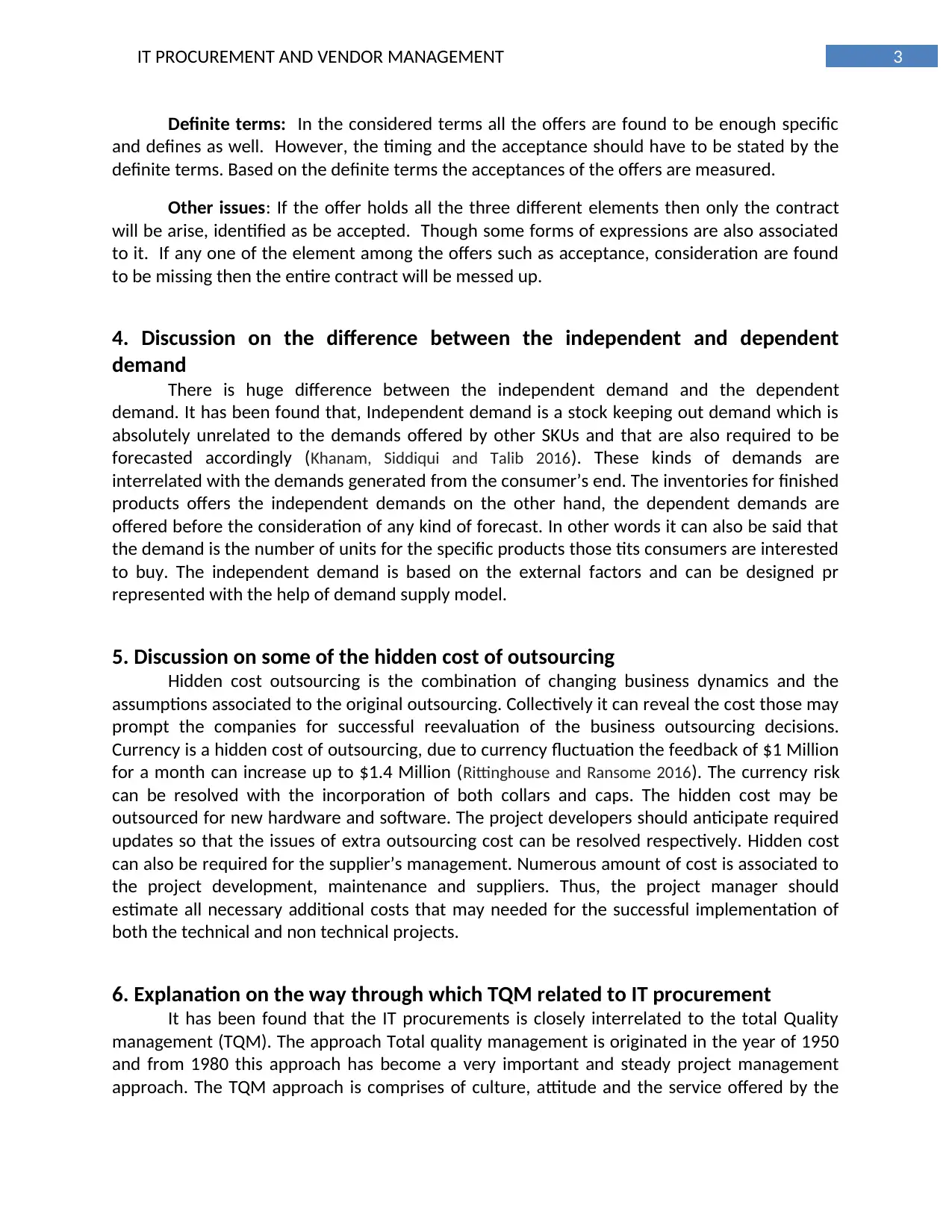
3IT PROCUREMENT AND VENDOR MANAGEMENT
Definite terms: In the considered terms all the offers are found to be enough specific
and defines as well. However, the timing and the acceptance should have to be stated by the
definite terms. Based on the definite terms the acceptances of the offers are measured.
Other issues: If the offer holds all the three different elements then only the contract
will be arise, identified as be accepted. Though some forms of expressions are also associated
to it. If any one of the element among the offers such as acceptance, consideration are found
to be missing then the entire contract will be messed up.
4. Discussion on the difference between the independent and dependent
demand
There is huge difference between the independent demand and the dependent
demand. It has been found that, Independent demand is a stock keeping out demand which is
absolutely unrelated to the demands offered by other SKUs and that are also required to be
forecasted accordingly (Khanam, Siddiqui and Talib 2016). These kinds of demands are
interrelated with the demands generated from the consumer’s end. The inventories for finished
products offers the independent demands on the other hand, the dependent demands are
offered before the consideration of any kind of forecast. In other words it can also be said that
the demand is the number of units for the specific products those tits consumers are interested
to buy. The independent demand is based on the external factors and can be designed pr
represented with the help of demand supply model.
5. Discussion on some of the hidden cost of outsourcing
Hidden cost outsourcing is the combination of changing business dynamics and the
assumptions associated to the original outsourcing. Collectively it can reveal the cost those may
prompt the companies for successful reevaluation of the business outsourcing decisions.
Currency is a hidden cost of outsourcing, due to currency fluctuation the feedback of $1 Million
for a month can increase up to $1.4 Million (Rittinghouse and Ransome 2016). The currency risk
can be resolved with the incorporation of both collars and caps. The hidden cost may be
outsourced for new hardware and software. The project developers should anticipate required
updates so that the issues of extra outsourcing cost can be resolved respectively. Hidden cost
can also be required for the supplier’s management. Numerous amount of cost is associated to
the project development, maintenance and suppliers. Thus, the project manager should
estimate all necessary additional costs that may needed for the successful implementation of
both the technical and non technical projects.
6. Explanation on the way through which TQM related to IT procurement
It has been found that the IT procurements is closely interrelated to the total Quality
management (TQM). The approach Total quality management is originated in the year of 1950
and from 1980 this approach has become a very important and steady project management
approach. The TQM approach is comprises of culture, attitude and the service offered by the
Definite terms: In the considered terms all the offers are found to be enough specific
and defines as well. However, the timing and the acceptance should have to be stated by the
definite terms. Based on the definite terms the acceptances of the offers are measured.
Other issues: If the offer holds all the three different elements then only the contract
will be arise, identified as be accepted. Though some forms of expressions are also associated
to it. If any one of the element among the offers such as acceptance, consideration are found
to be missing then the entire contract will be messed up.
4. Discussion on the difference between the independent and dependent
demand
There is huge difference between the independent demand and the dependent
demand. It has been found that, Independent demand is a stock keeping out demand which is
absolutely unrelated to the demands offered by other SKUs and that are also required to be
forecasted accordingly (Khanam, Siddiqui and Talib 2016). These kinds of demands are
interrelated with the demands generated from the consumer’s end. The inventories for finished
products offers the independent demands on the other hand, the dependent demands are
offered before the consideration of any kind of forecast. In other words it can also be said that
the demand is the number of units for the specific products those tits consumers are interested
to buy. The independent demand is based on the external factors and can be designed pr
represented with the help of demand supply model.
5. Discussion on some of the hidden cost of outsourcing
Hidden cost outsourcing is the combination of changing business dynamics and the
assumptions associated to the original outsourcing. Collectively it can reveal the cost those may
prompt the companies for successful reevaluation of the business outsourcing decisions.
Currency is a hidden cost of outsourcing, due to currency fluctuation the feedback of $1 Million
for a month can increase up to $1.4 Million (Rittinghouse and Ransome 2016). The currency risk
can be resolved with the incorporation of both collars and caps. The hidden cost may be
outsourced for new hardware and software. The project developers should anticipate required
updates so that the issues of extra outsourcing cost can be resolved respectively. Hidden cost
can also be required for the supplier’s management. Numerous amount of cost is associated to
the project development, maintenance and suppliers. Thus, the project manager should
estimate all necessary additional costs that may needed for the successful implementation of
both the technical and non technical projects.
6. Explanation on the way through which TQM related to IT procurement
It has been found that the IT procurements is closely interrelated to the total Quality
management (TQM). The approach Total quality management is originated in the year of 1950
and from 1980 this approach has become a very important and steady project management
approach. The TQM approach is comprises of culture, attitude and the service offered by the
Paraphrase This Document
Need a fresh take? Get an instant paraphrase of this document with our AI Paraphraser
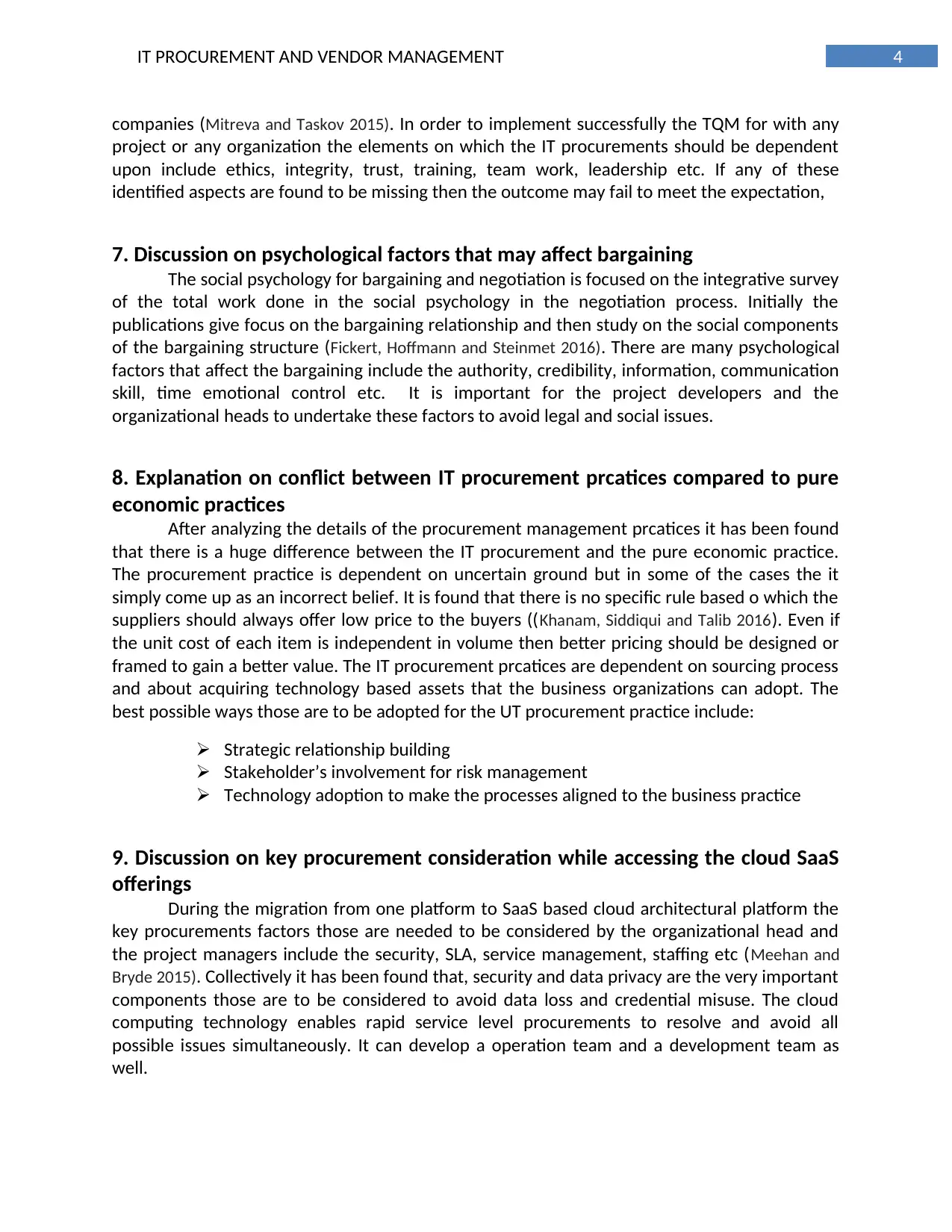
4IT PROCUREMENT AND VENDOR MANAGEMENT
companies (Mitreva and Taskov 2015). In order to implement successfully the TQM for with any
project or any organization the elements on which the IT procurements should be dependent
upon include ethics, integrity, trust, training, team work, leadership etc. If any of these
identified aspects are found to be missing then the outcome may fail to meet the expectation,
7. Discussion on psychological factors that may affect bargaining
The social psychology for bargaining and negotiation is focused on the integrative survey
of the total work done in the social psychology in the negotiation process. Initially the
publications give focus on the bargaining relationship and then study on the social components
of the bargaining structure (Fickert, Hoffmann and Steinmet 2016). There are many psychological
factors that affect the bargaining include the authority, credibility, information, communication
skill, time emotional control etc. It is important for the project developers and the
organizational heads to undertake these factors to avoid legal and social issues.
8. Explanation on conflict between IT procurement prcatices compared to pure
economic practices
After analyzing the details of the procurement management prcatices it has been found
that there is a huge difference between the IT procurement and the pure economic practice.
The procurement practice is dependent on uncertain ground but in some of the cases the it
simply come up as an incorrect belief. It is found that there is no specific rule based o which the
suppliers should always offer low price to the buyers ((Khanam, Siddiqui and Talib 2016). Even if
the unit cost of each item is independent in volume then better pricing should be designed or
framed to gain a better value. The IT procurement prcatices are dependent on sourcing process
and about acquiring technology based assets that the business organizations can adopt. The
best possible ways those are to be adopted for the UT procurement practice include:
Strategic relationship building
Stakeholder’s involvement for risk management
Technology adoption to make the processes aligned to the business practice
9. Discussion on key procurement consideration while accessing the cloud SaaS
offerings
During the migration from one platform to SaaS based cloud architectural platform the
key procurements factors those are needed to be considered by the organizational head and
the project managers include the security, SLA, service management, staffing etc (Meehan and
Bryde 2015). Collectively it has been found that, security and data privacy are the very important
components those are to be considered to avoid data loss and credential misuse. The cloud
computing technology enables rapid service level procurements to resolve and avoid all
possible issues simultaneously. It can develop a operation team and a development team as
well.
companies (Mitreva and Taskov 2015). In order to implement successfully the TQM for with any
project or any organization the elements on which the IT procurements should be dependent
upon include ethics, integrity, trust, training, team work, leadership etc. If any of these
identified aspects are found to be missing then the outcome may fail to meet the expectation,
7. Discussion on psychological factors that may affect bargaining
The social psychology for bargaining and negotiation is focused on the integrative survey
of the total work done in the social psychology in the negotiation process. Initially the
publications give focus on the bargaining relationship and then study on the social components
of the bargaining structure (Fickert, Hoffmann and Steinmet 2016). There are many psychological
factors that affect the bargaining include the authority, credibility, information, communication
skill, time emotional control etc. It is important for the project developers and the
organizational heads to undertake these factors to avoid legal and social issues.
8. Explanation on conflict between IT procurement prcatices compared to pure
economic practices
After analyzing the details of the procurement management prcatices it has been found
that there is a huge difference between the IT procurement and the pure economic practice.
The procurement practice is dependent on uncertain ground but in some of the cases the it
simply come up as an incorrect belief. It is found that there is no specific rule based o which the
suppliers should always offer low price to the buyers ((Khanam, Siddiqui and Talib 2016). Even if
the unit cost of each item is independent in volume then better pricing should be designed or
framed to gain a better value. The IT procurement prcatices are dependent on sourcing process
and about acquiring technology based assets that the business organizations can adopt. The
best possible ways those are to be adopted for the UT procurement practice include:
Strategic relationship building
Stakeholder’s involvement for risk management
Technology adoption to make the processes aligned to the business practice
9. Discussion on key procurement consideration while accessing the cloud SaaS
offerings
During the migration from one platform to SaaS based cloud architectural platform the
key procurements factors those are needed to be considered by the organizational head and
the project managers include the security, SLA, service management, staffing etc (Meehan and
Bryde 2015). Collectively it has been found that, security and data privacy are the very important
components those are to be considered to avoid data loss and credential misuse. The cloud
computing technology enables rapid service level procurements to resolve and avoid all
possible issues simultaneously. It can develop a operation team and a development team as
well.
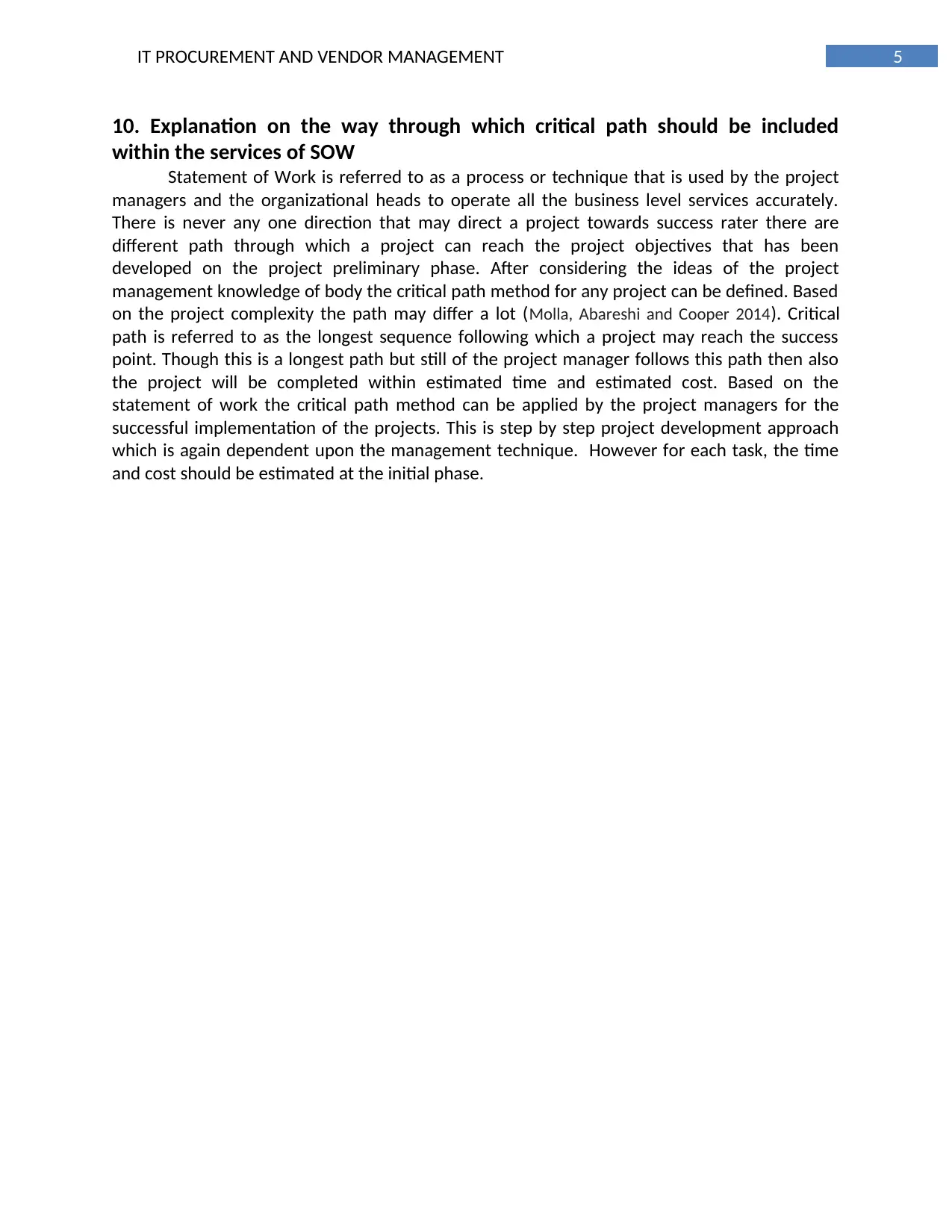
5IT PROCUREMENT AND VENDOR MANAGEMENT
10. Explanation on the way through which critical path should be included
within the services of SOW
Statement of Work is referred to as a process or technique that is used by the project
managers and the organizational heads to operate all the business level services accurately.
There is never any one direction that may direct a project towards success rater there are
different path through which a project can reach the project objectives that has been
developed on the project preliminary phase. After considering the ideas of the project
management knowledge of body the critical path method for any project can be defined. Based
on the project complexity the path may differ a lot (Molla, Abareshi and Cooper 2014). Critical
path is referred to as the longest sequence following which a project may reach the success
point. Though this is a longest path but still of the project manager follows this path then also
the project will be completed within estimated time and estimated cost. Based on the
statement of work the critical path method can be applied by the project managers for the
successful implementation of the projects. This is step by step project development approach
which is again dependent upon the management technique. However for each task, the time
and cost should be estimated at the initial phase.
10. Explanation on the way through which critical path should be included
within the services of SOW
Statement of Work is referred to as a process or technique that is used by the project
managers and the organizational heads to operate all the business level services accurately.
There is never any one direction that may direct a project towards success rater there are
different path through which a project can reach the project objectives that has been
developed on the project preliminary phase. After considering the ideas of the project
management knowledge of body the critical path method for any project can be defined. Based
on the project complexity the path may differ a lot (Molla, Abareshi and Cooper 2014). Critical
path is referred to as the longest sequence following which a project may reach the success
point. Though this is a longest path but still of the project manager follows this path then also
the project will be completed within estimated time and estimated cost. Based on the
statement of work the critical path method can be applied by the project managers for the
successful implementation of the projects. This is step by step project development approach
which is again dependent upon the management technique. However for each task, the time
and cost should be estimated at the initial phase.
⊘ This is a preview!⊘
Do you want full access?
Subscribe today to unlock all pages.

Trusted by 1+ million students worldwide
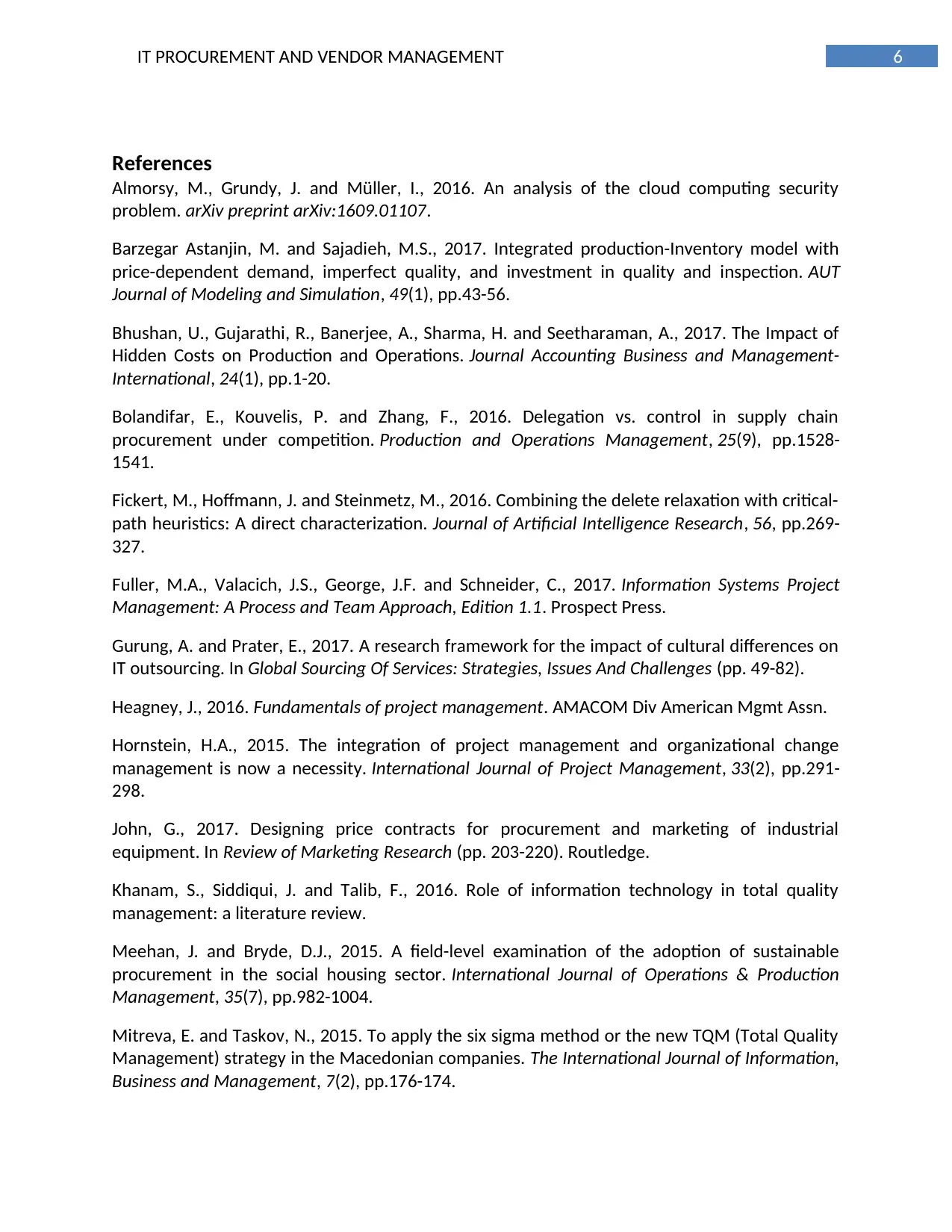
6IT PROCUREMENT AND VENDOR MANAGEMENT
References
Almorsy, M., Grundy, J. and Müller, I., 2016. An analysis of the cloud computing security
problem. arXiv preprint arXiv:1609.01107.
Barzegar Astanjin, M. and Sajadieh, M.S., 2017. Integrated production-Inventory model with
price-dependent demand, imperfect quality, and investment in quality and inspection. AUT
Journal of Modeling and Simulation, 49(1), pp.43-56.
Bhushan, U., Gujarathi, R., Banerjee, A., Sharma, H. and Seetharaman, A., 2017. The Impact of
Hidden Costs on Production and Operations. Journal Accounting Business and Management-
International, 24(1), pp.1-20.
Bolandifar, E., Kouvelis, P. and Zhang, F., 2016. Delegation vs. control in supply chain
procurement under competition. Production and Operations Management, 25(9), pp.1528-
1541.
Fickert, M., Hoffmann, J. and Steinmetz, M., 2016. Combining the delete relaxation with critical-
path heuristics: A direct characterization. Journal of Artificial Intelligence Research, 56, pp.269-
327.
Fuller, M.A., Valacich, J.S., George, J.F. and Schneider, C., 2017. Information Systems Project
Management: A Process and Team Approach, Edition 1.1. Prospect Press.
Gurung, A. and Prater, E., 2017. A research framework for the impact of cultural differences on
IT outsourcing. In Global Sourcing Of Services: Strategies, Issues And Challenges (pp. 49-82).
Heagney, J., 2016. Fundamentals of project management. AMACOM Div American Mgmt Assn.
Hornstein, H.A., 2015. The integration of project management and organizational change
management is now a necessity. International Journal of Project Management, 33(2), pp.291-
298.
John, G., 2017. Designing price contracts for procurement and marketing of industrial
equipment. In Review of Marketing Research (pp. 203-220). Routledge.
Khanam, S., Siddiqui, J. and Talib, F., 2016. Role of information technology in total quality
management: a literature review.
Meehan, J. and Bryde, D.J., 2015. A field-level examination of the adoption of sustainable
procurement in the social housing sector. International Journal of Operations & Production
Management, 35(7), pp.982-1004.
Mitreva, E. and Taskov, N., 2015. To apply the six sigma method or the new TQM (Total Quality
Management) strategy in the Macedonian companies. The International Journal of Information,
Business and Management, 7(2), pp.176-174.
References
Almorsy, M., Grundy, J. and Müller, I., 2016. An analysis of the cloud computing security
problem. arXiv preprint arXiv:1609.01107.
Barzegar Astanjin, M. and Sajadieh, M.S., 2017. Integrated production-Inventory model with
price-dependent demand, imperfect quality, and investment in quality and inspection. AUT
Journal of Modeling and Simulation, 49(1), pp.43-56.
Bhushan, U., Gujarathi, R., Banerjee, A., Sharma, H. and Seetharaman, A., 2017. The Impact of
Hidden Costs on Production and Operations. Journal Accounting Business and Management-
International, 24(1), pp.1-20.
Bolandifar, E., Kouvelis, P. and Zhang, F., 2016. Delegation vs. control in supply chain
procurement under competition. Production and Operations Management, 25(9), pp.1528-
1541.
Fickert, M., Hoffmann, J. and Steinmetz, M., 2016. Combining the delete relaxation with critical-
path heuristics: A direct characterization. Journal of Artificial Intelligence Research, 56, pp.269-
327.
Fuller, M.A., Valacich, J.S., George, J.F. and Schneider, C., 2017. Information Systems Project
Management: A Process and Team Approach, Edition 1.1. Prospect Press.
Gurung, A. and Prater, E., 2017. A research framework for the impact of cultural differences on
IT outsourcing. In Global Sourcing Of Services: Strategies, Issues And Challenges (pp. 49-82).
Heagney, J., 2016. Fundamentals of project management. AMACOM Div American Mgmt Assn.
Hornstein, H.A., 2015. The integration of project management and organizational change
management is now a necessity. International Journal of Project Management, 33(2), pp.291-
298.
John, G., 2017. Designing price contracts for procurement and marketing of industrial
equipment. In Review of Marketing Research (pp. 203-220). Routledge.
Khanam, S., Siddiqui, J. and Talib, F., 2016. Role of information technology in total quality
management: a literature review.
Meehan, J. and Bryde, D.J., 2015. A field-level examination of the adoption of sustainable
procurement in the social housing sector. International Journal of Operations & Production
Management, 35(7), pp.982-1004.
Mitreva, E. and Taskov, N., 2015. To apply the six sigma method or the new TQM (Total Quality
Management) strategy in the Macedonian companies. The International Journal of Information,
Business and Management, 7(2), pp.176-174.
Paraphrase This Document
Need a fresh take? Get an instant paraphrase of this document with our AI Paraphraser
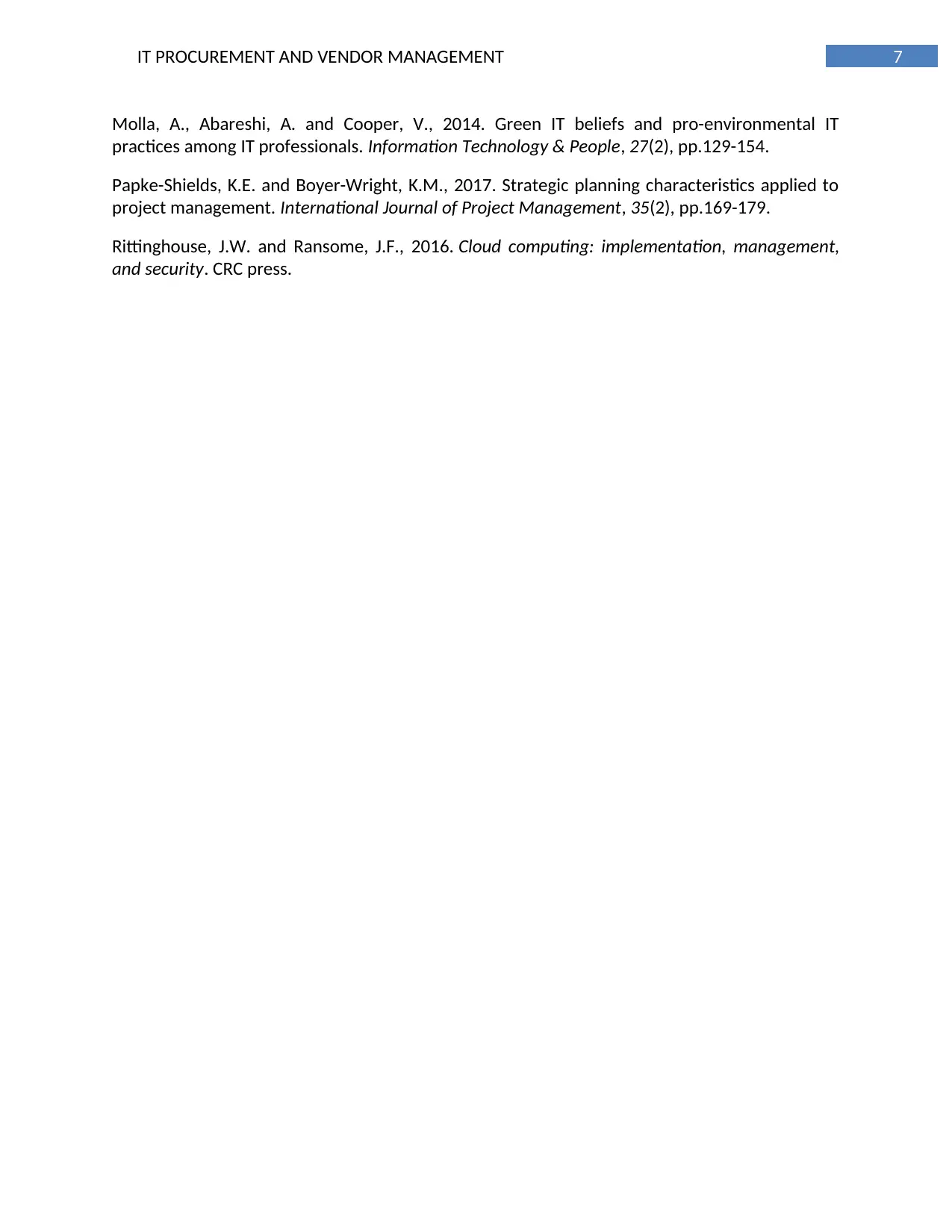
7IT PROCUREMENT AND VENDOR MANAGEMENT
Molla, A., Abareshi, A. and Cooper, V., 2014. Green IT beliefs and pro-environmental IT
practices among IT professionals. Information Technology & People, 27(2), pp.129-154.
Papke-Shields, K.E. and Boyer-Wright, K.M., 2017. Strategic planning characteristics applied to
project management. International Journal of Project Management, 35(2), pp.169-179.
Rittinghouse, J.W. and Ransome, J.F., 2016. Cloud computing: implementation, management,
and security. CRC press.
Molla, A., Abareshi, A. and Cooper, V., 2014. Green IT beliefs and pro-environmental IT
practices among IT professionals. Information Technology & People, 27(2), pp.129-154.
Papke-Shields, K.E. and Boyer-Wright, K.M., 2017. Strategic planning characteristics applied to
project management. International Journal of Project Management, 35(2), pp.169-179.
Rittinghouse, J.W. and Ransome, J.F., 2016. Cloud computing: implementation, management,
and security. CRC press.
1 out of 8
Related Documents
Your All-in-One AI-Powered Toolkit for Academic Success.
+13062052269
info@desklib.com
Available 24*7 on WhatsApp / Email
![[object Object]](/_next/static/media/star-bottom.7253800d.svg)
Unlock your academic potential
Copyright © 2020–2025 A2Z Services. All Rights Reserved. Developed and managed by ZUCOL.





